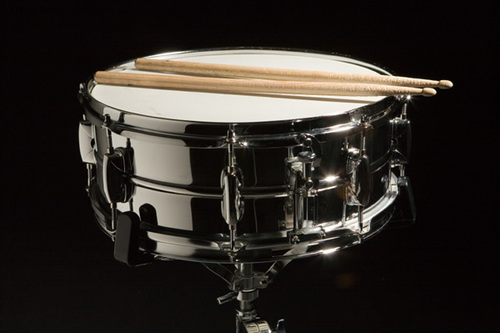Drums and Physics
 A snare is one of the compounds that form drums. The picture above shows an example of a snare. The white part, under the sticks, is the snare's skin. When one hits the skin with a stick, the skin moves down and starts to vibrate, as one has hit a spring. If one holds the stick above the snare's skin and lets the stick fall, it will bounce a few times and, then, stop. Considering that
is the stick's acceleration when it is going up,
is the skin's speed when it is going up,
is the stick's mass,
is the skin's elastic constant,
is the stick's speed when it is going up (starting from origin) and
is the gravitational acceleration, what is the sum of all the maximum heights to which the stick goes while bouncing, until it stops?
A snare is one of the compounds that form drums. The picture above shows an example of a snare. The white part, under the sticks, is the snare's skin. When one hits the skin with a stick, the skin moves down and starts to vibrate, as one has hit a spring. If one holds the stick above the snare's skin and lets the stick fall, it will bounce a few times and, then, stop. Considering that
is the stick's acceleration when it is going up,
is the skin's speed when it is going up,
is the stick's mass,
is the skin's elastic constant,
is the stick's speed when it is going up (starting from origin) and
is the gravitational acceleration, what is the sum of all the maximum heights to which the stick goes while bouncing, until it stops?
Notes and Assumptions :
-
Do consider that the downward motions have positive values. Take the initial position ( , the origin) to be the snare's skin in its original position. Consider that, when the stick hits the skin, it completely "stops", but continues going down by Inertia (touching the skin), but do consider its speed is 0.
-
There is no loss of energy, with one exception: energy convertion into sound energy, what makes the stick stop on the bounce . Every bounce has a maximum height when the stick goes up. Use the origin as reference to calculate the heights .
-
The snare's skin completely stops when it reaches its original position. The skin doesn't go upwards, just downwards and then it instantly stops.
Image credit: Gb Music Studio.
This section requires Javascript.
You are seeing this because something didn't load right. We suggest you, (a) try
refreshing the page, (b) enabling javascript if it is disabled on your browser and,
finally, (c)
loading the
non-javascript version of this page
. We're sorry about the hassle.
When the stick hits the snare's skin, it follows the skin's movement, and when the skin starts to move upwards, so does the stick, with same speed and acceleration. So, after hitting the skin, the stick reaches a speed of 0 when it gets to the point in which the snare's skin will start to go back.When the skin stops at the origin, where S = 0, the stick continues to go up. At the stick's maximum height, its speed is 0, so v x = − v + g t ⇒ 0 = − v + g t ⇒ t = g v . Note that the negative and positive sinals were changed because of the referencial that must be taken. Also note that "t" is the time it takes the stick to get to its maximum height from the origin with an initial speed of "v". Let h i be the maximum height for a certain i bounce. Then h i = S o − v t + 2 g t 2 ⇒ h i = − v . g v + 2 g . g 2 v 2 ⇒ h i = − 2 g v 2 . Hence, the sum of all the maximum heights of the j bounces is ∑ n = 1 j h n = n = 1 ∑ j − 2 g v n 2